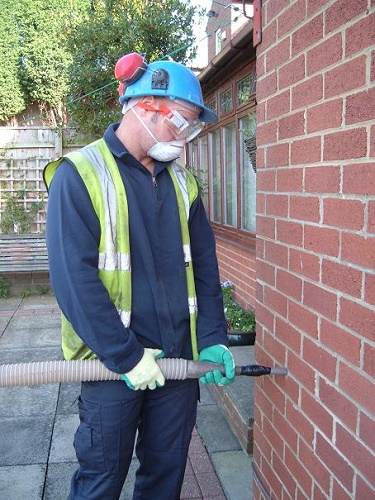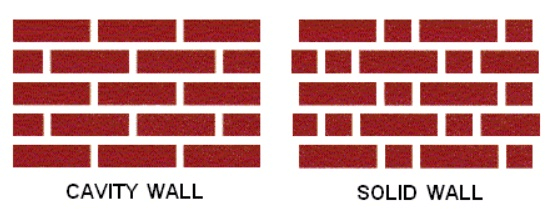Free Cavity Wall Insulation Grants 2025
Are you looking to make your home more energy-efficient while reducing your heating bills? Improve your home’s energy efficiency and reduce heating costs with a free cavity wall insulation grant. If you receive a qualifying benefit, Free Cavity Wall Insulation grants are available to cover the entire cost of professional installation. These grants are part of two major government-backed schemes:
Both schemes aim to improve the energy efficiency of homes with an EPC rating of D, E, F, or G and will run until March 2026.
Eligibility and Property Requirements:
- Your property must be privately owned or rented.
- The home must be occupied at the time of the survey.
- You or someone in your household should receive qualifying benefits (e.g., Universal Credit, Pension Credit, Child Tax Credit).
- Even without benefits, you may qualify if your annual household income is £31,000 or less.
If you’re not eligible for a free grant, we can still arrange a survey and quote from an approved Installer. Costs typically range from £1,000 to £4,600, depending on your property type and size.
With energy costs continuing to rise, Cavity Wall Insulation is one of the best ways to reduce your heating bills:
- Uninsulated cavity walls can cause up to 35% of a property’s heat to escape.
- Cavity Insulation can save a household up to £405 each year.
- It can reduce your carbon footprint by up to 1.1 tonnes annually.
100% of grants are subject to a free, no-obligation survey. In most cases, it’s entirely free, but you may be asked to pay a small contribution depending on your property’s size and efficiency.
Important Note: The UK Government is set to unveil the Warm Homes Plan in spring 2025, which may introduce new or modified grant opportunities.
Click here if you’re unsure whether you have Cavity Walls or if they’re already insulated.
How It Works
-
Complete Online Form
-
Free Survey Booked
-
Insulation Installed
-
Grant Claimed
Who Qualifies for Cavity Wall Insulation Grants in 2025?
Free cavity wall insulation is available through two government-backed schemes: the Great British Insulation Scheme (GBIS) and the Energy Company Obligation (ECO4). Here’s who may qualify:
Income-Based Eligibility
-
Households with a gross annual income of £31,000 or less.
Benefit Recipients
You may qualify if you or someone in your household receives:
-
Universal Credit
-
Housing Benefit (excluding single person’s 25% Council Tax reduction)
-
Child Benefit (subject to income thresholds)
-
Pension Credit (Savings or Guarantee)
-
Income Support
-
Income-Based Jobseekers Allowance
-
Income-Related Employment Support Allowance
-
Working Tax Credit
-
Child Tax Credit
Property Criteria
-
Homes with an EPC rating of D, E, F, or G.
-
Properties in Council Tax bands A to D in England, or A to E in Scotland and Wales.
-
Typically built between 1924 and 2005 with unfilled cavity walls.
Ownership and Occupancy
-
Homeowners and private tenants (with landlord permission) are eligible.
-
Housing Association tenants who own 50% or more of their property may qualify.
-
The property must be occupied, not empty or under refurbishment.
Additional Requirements
-
The wall area to be insulated must be at least 60% of the property size.
-
Extensions typically don’t qualify, but a free survey can be arranged.
Special Considerations
-
Priority given to low-income households, pensioners over 70, and those with health conditions affected by cold homes.
-
Local councils may refer vulnerable households through the ECO4 Flex program.
To confirm eligibility, arrange a free, no-obligation survey with an approved installer.
Visit our who qualifies for free insulation grants page for full details.
What Is Cavity Wall Insulation?
Recent data from the Department for Energy Security & Net Zero indicates that approximately 70% of properties with cavity walls in Great Britain have already had cavity wall insulation installed. This means around 30% of properties with cavity walls remain uninsulated, representing about 5.1 million homes that could still benefit from this energy-saving measure. Your property could be one of them.
What is it? Cavity wall insulation involves injecting insulating material into the gap (cavity) between the inner and outer walls of a building. This gap is commonly found in houses built after the 1920s. The insulation works by reducing heat loss, capturing air within the cavity, and preventing heat from escaping. This translates to reduced energy costs.
Types of Insulation Materials
Professional installers use high-quality materials to fill cavity walls, such as:
- Mineral Wool (Glass Fibre): Lightweight and effective at trapping heat.
- Polystyrene Beads: Durable and moisture-resistant.
- Foam Insulation: Provides excellent thermal performance.

See if you qualify:
Click HERE to Find Out >>Is My Property Suitable For Cavity Wall Insulation?
Before applying for a grant, it’s important to check if your home has cavity walls and whether it is suitable for insulation. While many UK homes can benefit from cavity wall insulation, not all properties are eligible. Here’s how to assess your home’s suitability:

Property Age and Wall Type
- Built Between 1924 and 1982: Most properties from this period have cavity walls, which are likely unfilled and suitable for insulation.
- Built After 1982: Building Regulations required cavity wall insulation during construction, but some homes built up to 2005 may still lack proper insulation.
- Built Before 1924: Homes built before this period typically have solid walls, which are not suitable for cavity wall insulation.
How to Identify Cavity Walls
- Wall Thickness: If your external walls are at least 250mm (10 inches) thick, they likely have a cavity.
- Brick Pattern: Properties with cavity walls often have bricks laid in a uniform pattern, whereas solid walls may have alternating brick patterns.
Unsuitable Properties
Your property may not be eligible for cavity wall insulation if:
- It was built before 1924 or after 2005.
- The walls are already insulated. Cavity wall insulation cannot be topped up.
- There are signs of dampness on the internal or external walls.
- The property is timber/steel-framed, concrete, or stone.
- Ventilation is inadequate, and additional vents cannot be installed.
- You live in a flat without agreement from neighbours above and below.
Alternative Solutions for Solid Walls
If your property has solid walls or is otherwise unsuitable for cavity wall insulation, you may still qualify for grants to install:
These measures can also significantly improve energy efficiency and reduce heating costs.
Cavity Wall Insulation FAQs
How long does it take to install Cavity Wall Insulation?
An averaged size property will take around two to three hours.
Will I receive a guarantee?
Yes. The Installer will apply for a 25 year guarantee through one of three organisations: CIGA, Kinnell or GDGC.
How can I tell if my walls are already filled with Cavity Wall Insulation?
If you look closely, especially under the windows, you may be able to see where holes have been drilled and filled with cement. The holes are drilled where the mortar forms a T joint.
Can I get Cavity Wall Insulation if I live in a flat?
The Insulation must be installed from the ground floor to the roof. Each property is assessed individually for the grant, so you must have the consent of any neighbours above and below before you make an application.
What if I have damp in my walls?
You will need to have the problem checked and repaired before applying for Cavity Wall Insulation through FreeInsulation. A local builder may be able to help you to assess this.
Are there any health risks from Cavity Wall Insulation?
No. The Insulation is sealed within the walls. If glass fibre is used, this is derived from sand which fits in with the natural brick and mortar fabric of the property.
Where can I find more information?
Visit the CIGA website to find out more about Cavity Wall Insulation: www.ciga.co.uk.
How Much Can Cavity Wall Insulation Save?
Cavity Wall Insulation prevents up to 35% of the heat generated in your home from escaping. This results in lower energy bills because your heating can be turned on less often, at a lower temperature and for shorter periods. Savings of up to £145 per year are possible.
Because less fossil fuel is being burned, Cavity Wall Insulation will also reduce carbon emissions by up to 610kg per year, therefore helping to protect the environment from climate change.
Savings figures are based on Energy Saving Trust estimates for a semi-detached property heated by gas.
How can FreeInsulation help?
Our online form will make sure an approved Installer operates in your area, check that your property is likely to be suitable and give you an indication of whether you are likely to qualify for a Cavity Wall Insulation Grant. You can then enter your details and an approved Installer / Surveyor will contact you to book a no-obligation survey.
If you are happy to proceed, the Installer will arrange the work. Once the Cavity Wall Insulation is fitted, if you are entitled to a grant, our Installer will claim the Grant amount from an Energy Company or one of their agents. They will then apply for the 25 year Cavity Guarantee through CIGA, Kinnell or GDGC.
